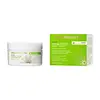What's inside
What's inside
 Key Ingredients
Key Ingredients

 Benefits
Benefits

 Concerns
Concerns

 Ingredients Side-by-side
Ingredients Side-by-side

Water
Skin ConditioningStearic Acid
CleansingLinum Usitatissimum Seed Oil
PerfumingGlycine Soja Oil
EmollientGlycerin
HumectantPropylene Glycol
HumectantGelatin
Parfum
MaskingPhenoxyethanol
PreservativeAmmonium Hydroxide
BufferingMethylparaben
PreservativeCamphor
MaskingMenthol
MaskingDMDM Hydantoin
PreservativePropylparaben
PreservativeCalcium Hydroxide
BufferingEucalyptus Globulus Leaf Oil
PerfumingDisodium EDTA
Sodium Bicarbonate
AbrasiveCalcium Chloride
AstringentMagnesium Sulfate
Potassium Chloride
Water, Stearic Acid, Linum Usitatissimum Seed Oil, Glycine Soja Oil, Glycerin, Propylene Glycol, Gelatin, Parfum, Phenoxyethanol, Ammonium Hydroxide, Methylparaben, Camphor, Menthol, DMDM Hydantoin, Propylparaben, Calcium Hydroxide, Eucalyptus Globulus Leaf Oil, Disodium EDTA, Sodium Bicarbonate, Calcium Chloride, Magnesium Sulfate, Potassium Chloride
Water
Skin ConditioningCitrus Paradisi Seed Oil
PerfumingZinc Oxide
Cosmetic ColorantTitanium Dioxide
Cosmetic ColorantCetyl Alcohol
EmollientGlyceryl Stearate
EmollientColloidal Sulfur
AntimicrobialCamphor
MaskingSalicylic Acid
MaskingBentonite
AbsorbentRubus Idaeus Fruit Extract
AstringentStrelitzia Nicolai Seed Aril Extract
Skin ConditioningVitis Vinifera Juice Extract
AntioxidantSymphytum Officinale Leaf Extract
Skin ConditioningSophora Japonica Flower Extract
Skin ProtectingCamellia Sinensis Leaf Extract
AntimicrobialLepidium Sativum Sprout Extract
Skin ConditioningLecithin
EmollientGlycerin
HumectantPhenoxyethanol
PreservativeEthylhexylglycerin
Skin ConditioningWater, Citrus Paradisi Seed Oil, Zinc Oxide, Titanium Dioxide, Cetyl Alcohol, Glyceryl Stearate, Colloidal Sulfur, Camphor, Salicylic Acid, Bentonite, Rubus Idaeus Fruit Extract, Strelitzia Nicolai Seed Aril Extract, Vitis Vinifera Juice Extract, Symphytum Officinale Leaf Extract, Sophora Japonica Flower Extract, Camellia Sinensis Leaf Extract, Lepidium Sativum Sprout Extract, Lecithin, Glycerin, Phenoxyethanol, Ethylhexylglycerin
Ingredients Explained
These ingredients are found in both products.
Ingredients higher up in an ingredient list are typically present in a larger amount.
Camphor is a waxy solid with a strong scent. It is made using turpentine oil.
This ingredient is used for medicinal purposes due to its cooling effect. In medicine, camphor is a common anti-inflammation ingredient.
Camphor also possesses antibacterial and antifungal properties.
One study found camphor to be a potential anti-wrinkle ingredient. This might be due to its ability to increase elastin and collagen production. Collagen and elastin are responsible for plump and youthful looking skin.
It is best to use cosmetics with a small amount of camphor under 11%. Using topical camphor may induce irritation and redness.
In the past, camphor was traditionally made by distilling the wood of the camphor tree.
Learn more about CamphorGlycerin is already naturally found in your skin. It helps moisturize and protect your skin.
A study from 2016 found glycerin to be more effective as a humectant than AHAs and hyaluronic acid.
As a humectant, it helps the skin stay hydrated by pulling moisture to your skin. The low molecular weight of glycerin allows it to pull moisture into the deeper layers of your skin.
Hydrated skin improves your skin barrier; Your skin barrier helps protect against irritants and bacteria.
Glycerin has also been found to have antimicrobial and antiviral properties. Due to these properties, glycerin is often used in wound and burn treatments.
In cosmetics, glycerin is usually derived from plants such as soybean or palm. However, it can also be sourced from animals, such as tallow or animal fat.
This ingredient is organic, colorless, odorless, and non-toxic.
Glycerin is the name for this ingredient in American English. British English uses Glycerol/Glycerine.
Learn more about GlycerinPhenoxyethanol is a preservative that has germicide, antimicrobial, and aromatic properties. Studies show that phenoxyethanol can prevent microbial growth. By itself, it has a scent that is similar to that of a rose.
It's often used in formulations along with Caprylyl Glycol to preserve the shelf life of products.
Water. It's the most common cosmetic ingredient of all. You'll usually see it at the top of ingredient lists, meaning that it makes up the largest part of the product.
So why is it so popular? Water most often acts as a solvent - this means that it helps dissolve other ingredients into the formulation.
You'll also recognize water as that liquid we all need to stay alive. If you see this, drink a glass of water. Stay hydrated!
Learn more about Water